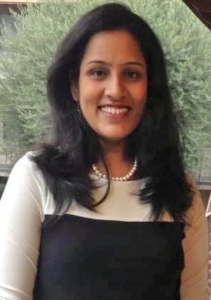We met virtually with Rekha Prakash, a Biotechnology Instructor at Roosevelt High School who also plays a role in the Medical & Health Sciences Linked Learning pathway and as an advisor to the Health Occupations Students of America to hear about how distance learning has been going for her and her students. Read more below.

Rekha enjoys seeing students develop an interest in biotechnology and/or similar sciences.
Distance learning has reached its one-year mark. What was one of the biggest challenges experienced by your students and peers?
Initially, the biggest challenge was access to technology for our students. Students were being expected to use devices in different ways than they were expected to in classrooms. Without a teacher there to help them with downloading and troubleshooting, supporting our students was crucial to their success. I really applaud my school administrators for prioritizing this and for their continued support to ensure that all students have their technology needs met.
How did social-emotional learning factor into distance learning?
The social-emotional challenges for my students are very real. It’s been difficult for them. They really wanted to be in the classroom, and balancing school and other things like work and home life have been tough. I do my best to show students that they can come to me if they need someone to talk to, and I try to provide the support they need at that time. It’s important to me to respect the feelings of students, families, and their communities, and the challenges they face. This school year, I have adjusted my grading strategies by collaborating with one of my mentor science teachers to provide students with more flexibility in supporting their efforts and mastery of the content. I made sure I was flexible with my time as much as possible. I observed that these changes helped to engage my students online in different ways – sometimes with emoji reactions or through the chat features in our learning software programs. This has led to strengthening the trust between me and my students, and many have told me that they really appreciated speaking with me about their challenges this year.
Were there new opportunities or things you discovered that worked well in distance learning?
The pandemic gave me an opportunity to teach about something that is very relevant to biotechnology. We studied COVID-19 data, and it really showed students the importance of math, and how to use it in the real world. For example, students analyzed data and came to understand the significant role math and data analysis play in combatting diseases. “I never knew we could use math like this” was something I heard often from students. I also had the opportunity to collaborate on COVID-19 lessons with my peers. With math and science teachers involved, we created an interdisciplinary learning effort and came up with a topic around how data extraction and analysis play important roles in the response efforts to this global pandemic. Once students learned what it takes to find cures for diseases, they began to see linkages between their coursework and real-life examples. This type of approach helps students develop an interest in biotechnology and/or similar fields, and pursue it in college. In addition to data analysis, we tried new STEM-related apps and software programs that sparked student creativity. Some of my students were so motivated that they explored the creation of apps, specifically developing programs that support social-emotional wellness during a pandemic. This free-range of creativity allowed for students to actively engage with the coursework and build confidence in their learning and approach to innovative solutions.
Is there anything else you would like to add?
I think successful teaching is about collaboration. Partnering with other teachers is important. I am privileged that I have been able to learn from my peers, and I’m happy to collaborate with them. If you’re a teacher interested in starting a project, I suggest starting by gathering input and perspectives from other educators, biotechnology industry partners, and pathway alumni students. Then think about the external connections to the real world. For my work in biotechnology, I have collaborated with my alma mater to support the USC Stem Cell Scholars program, and also collaborate with various industry partners such as AMGEN, Pasadena City College, UCLA Health, Oak Crest Institute of Science, and so on. Biotechnology is a broad field that is constantly evolving, and updating curriculum is important. Ask yourself, “how am I stimulating curiosity for my students?” Respond to what sparks their curiosity. I have Roosevelt medical pathway alumni who are currently pursuing degrees related to biotechnology/biomedical sciences. There are so many career possibilities within this field and I think sparking that curiosity and showing what’s possible really helps students stay engaged, even in distance learning.
